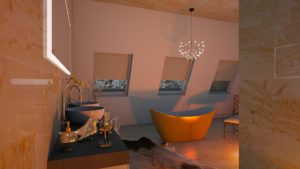 Finishing stage of any construction – facing of a facade. That it is the central element of home decoration. Facade cladding materials, along with roofing, can highlight the merits of architecture or spoil the overall impression of the building. Since the best natural materials for tiling are distinguished by high cost, there is a constant search for high-quality substitutes for them. One of these artificial materials – porcelain, which is very close in its qualities to the prototype.
Finishing stage of any construction – facing of a facade. That it is the central element of home decoration. Facade cladding materials, along with roofing, can highlight the merits of architecture or spoil the overall impression of the building. Since the best natural materials for tiling are distinguished by high cost, there is a constant search for high-quality substitutes for them. One of these artificial materials – porcelain, which is very close in its qualities to the prototype.
Technical characteristics and advantages of ceramic granite
As well as a usual facing tile, ceramic granite is made of clay with special additives. Technologically, porcelain stoneware is manufactured at high pressure and at high temperatures. This gives it qualities close to natural granite – strength, monolithic, low porous structure, water resistance. Imitation of granite has advantages over natural material. First of all – it is low cost.
The great advantage of artificial material is that the use of specified forms gives it a certain shape and size, the texture of the outer surface, without requiring long work on cutting, cutting, grinding and polishing, which are necessary in the manufacture of granite cladding. A varied uniform color of porcelain stoneware can also be added, which expands the decorative possibilities of the material. Facing tiles are not afraid of water, temperature changes, chemical atmospheric effects. This makes ceramic granite suitable for use in interior decoration and for facade work.
High resistance to abrasion at low cost – allows economical use of material for flooring in buildings with high attendance and high load on the floor: airports, train stations, public buildings, shopping centers.
Decorative possibilities of porcelain tile
Modern production offers builders different types and textures of ceramic granite. Structured porcelain stoneware looks like a wild stone – only upon careful examination you can see repetitive volumes and patterns of individual facing blocks. Unpolished material has a soft matte color and looks favorably in combination with wood and brick surfaces.
Polished ceramic granite with a mirror-like shiny surface is closest to natural material – it is difficult for an uninitiated person to distinguish between them. Artificial aging, which is subjected to rustic porcelain, allows it to imitate the old granite masonry.
When facing buildings with ceramic granite plates, it is better to contact an experienced professional designer who will be able to profitably use the best material properties, choose winning textures or their combinations.
Picture Credit: DarthZuzanka
